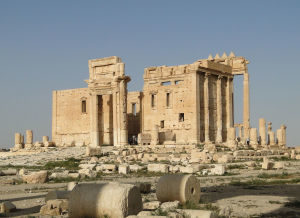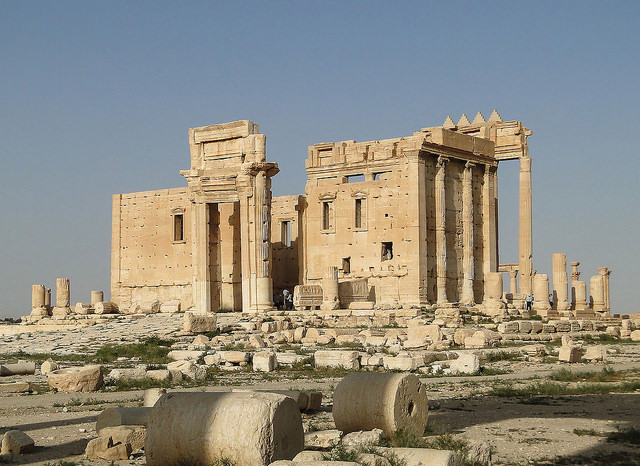
Just a few days after the liberation of Palmyra, Iconem – a French company specializing in the 3D digitization of unique and vulnerable archaeological sites – visited the devastated ancient city to carry out the first 3D survey of the damage.
As a long-term partner of the DGAM (Direction Générale des Antiquités et des Musées – the Syrian Directo- rate-General of Antiquities and Museums), the company accompanied the first group of Syrian scientists to arrive on the site on April 5, 2016.
A SOLUTION FOR SURVEYING MINED AREAS
The process of removing landmines from the site has not yet been completed, largely preventing ground-level photography, but Iconem’s drone-based photographic technology has provided a solution to this problem. The company applied expertise in 3D surveying and analyses to accurately determine the extent of the damage caused by the ISIS terrorists.
FIVE HIGH-PRIORITY SITES
In partnership with the DGAM, Iconem is currently establishing an accurate picture of the destruction affecting the temples of Bel and Baalshamin, the Monumental Arch, the Valley of Tombs and the museum; the five sites in Palmyra which have suffered the greatest damage. “The two temples and the arch have been demolished, but the majority of their component blocks are still present”, reported Iconem’s cofounder Yves Ubelmann from Syria. “They are spread across the area, but some of them are whole and have not been destroyed.”
However, the museum has been ransacked. The building has suffered extensive damage from missiles piercing the roof, and archaeological objects have been shattered. In particular, the heads of the statues have all been systematically defaced.
________________________________________
The Temple of Bel as it existed in 2010, before the destruction. Bernard Gagnon, Wikimedia Commons
____________________________________________________
SOME HOPE OF RECONSTRUCTION
However, there is hope that restoration may be possible: “The fragments of these objects have not been removed or sold; they have simply been abandoned where they lie”, Yves Ubelmann continued. “This means that there is some hope of reconstructing them.”
Iconem will be closely involved in the restoration works of the DGAM. The company’s highly accurate surveys will enable it to produce 3D models of the site that scientists from all over the world will be able to consult in order to analyze the damage and envisage possible restorations. For example, Iconem has already produced initial 3D models of the Citadel of Palmyra and the Temple of Bel (visuals below) which show the damage the buildings have suffered, and which can be viewed on the web platform sketchfab.
The Iconem/DGAM partnership is part of the “Syrian Heritage” project, a long-term program to document all of Syria’s threatened heritage with a view to preserving the memory of these sites. 3D models of three Syrian archaeological sites have been produced using the technique known as photogrammetry and are already freely accessible on the websites of Iconem and the DGAM.
In addition to the 3D digitization process currently under way in Syria, Iconem’s ambition is to preserve the memory of archaeological sites from all over the world in order to transmit them to future generations via a dedicated online platform available to the general public.
__________________________________________
Palmyra Citadel Comparison by Iconem on Sketchfab
The Palmyra castle or Fakhr-al-Din al-Ma’ani Castle was built by the Mamluks in the XIIIth century on a hill overlooking the antique city of Palmyra. Since 1980, the castle and Palmyra are both inscribed on UNESCO’s World Heritage List.
In May 2015, the castle was taken by ISIS troops because of its strong fortification and strategic location. During the Palmyra offensive in march 2016, the Syrian government’s army succeeded in retaking the city but the castle was unfortunately damaged by retreating ISIS fighters. The stairway leading to the entrance is now completely destroyed, as well as some of the eastern towers. The Syrian Director of the DGAM, Maamoun Abdelkarim, has declared that the castle will be restored.
In partnership with the DGAM, ICONEM contributes to the castle’s restoration by carrying out 3D models representing the castle before and after the conflict, which will be given to archeologists and restorers.
________________________________________________________
Temple of Bel by Iconem on Sketchfab
In partnership with the DGAM, the ICONEM’s team was the first one to be in Palmyra since Daesh’s departure. A new phase of the major project, Syrian Heritage, this mission afforded the opportunity to provide a clear picture of the damages suffered by the “pearl of the desert”, and more specifically by the Temple of Bel, as it has been left behind by Daesh fighters, using photogrammetry.
The digitalized 3D model allows us to observe the existence of stone blocks remaining almost intact, meaning that there might be some hope for a partial reconstruction. Some other blocks, however, have been dynamited.
ICONEM’s support in Palmyra has been essential to documenting the appearance and state of the site immediately after it’s liberation, which is going to be helpful to the scientific community.
Dedicated in 32 CE and consecrated to the protective divinity of Palmyra, the Mesopotamian god Bel, the Temple of Bel was, before its destruction, one of the best preserved ancient temples of Syria.
_________________________________________________________
Source: Adapted and edited from the subject Iconem pess releases.
_________________________________________________________
The French start-up company Iconem was created in 2013 by Yves Ubelmann, an architect specializing in archaeology, and Philippe Barthélémy, an airplane and helicopter pilot. The company is now a world leader in scanning unique archaeological sites and employs nine people – architects, engineers and graphic artists – who specialize in 3D production.
The company has made a name for itself by taking on unprecedented technological challenges, including the complete modelling of Pompeii as well as scanning sites in Syria, Afghanistan, Iraq and Haiti. All of these plans will soon be available to consult online on a special platform which constitutes a unique virtual digital encyclopaedia.
Using the latest technologies and procedures, drone photography and photogrammetry, Iconem works to preserve unique archaeological heritage sites from around the world, with the aim of keeping their memory alive for future generations.
See more about www.iconem.com.
________________________________________________________
Travel with Popular Archaeology and personally see some of the most exciting archaeological discoveries underpinning the historical basis for the places and events of the biblical accounts!
____________________________________

______________________________________________
Travel and learn with Far Horizons.
____________________________________________
This richly illustrated issue includes the following stories: Recent findings shedding new light on the whereabouts of the remains of Philip of Macedon, father of Alexander the Great; how an archaeologist-sculptor is bringing bones of the dead back to life; archaeologists uncovering town life at the dawn of civilization; an exclusive interview with internationally acclaimed archaeologist James M. Adovasio about what makes the Meadowcroft Rockshelter prominent in the ongoing search for the first Americans; what archaeologists are finding at the site of the ancient city of Gath, the home town of the biblical Philistine giant, Goliath; and how scientists are redrawing the picture of human evolution in Europe. Find it on Amazon.com.








